yogabook / asanas / hasta padangusthasana
Contents
hasta padangusthasana
„Hand-big toe position“

 instructions and details with working links as PDF for download/print
instructions and details with working links as PDF for download/print
Feedback: We’d love to hear what you think about this description, give us feedback at:
postmeister@yogabook.org
Last modified: 30.12.2018
Name: hasta padangusthasana
trivial name: hand-big toe pose
Level: FA
- classification
- contraindications
- effects
- preparation
- follow-up
- derived asanas
- similar asanas
- diagnostics
- instructions
- details
- variants
Classification
classic: standing pose
physiological: balance pose with ischiocrural stretching
Contraindication
Effects
- (842) Strengthening the dorsiflexors of the foot
- (852) Strengthening the calf muscles
- (862) Strengthening the supinators of the ankle
- (872) Strengthening the pronators of the ankle
- (721) Stretching the hamstrings
Preparation
An excessive hollow back when taking this pose indicates shortened hip flexors. For the risks of a hollow back that this often causes, see the FAQ. In cases of significantly restricted flexibility of the hip flexors, the supporting leg will have a marked tendency to bend, in which case the following preparations are suitable:
- hip opener 1
- hip opener 2
- warrior 1 pose with a strong straightening of the pelvis
- upface dog
- urdhva dhanurasana (back arch)
- ustrasana (camel)
- setu bandha sarvangasana
and other backbends with extension in the hip joint.
The greatest difficulty in this pose is probably a good flexion in the hip joint of the lifted leg, which also allows little evasive movement; the following preparations are suitable for this:
- uttanasana as a generally effective and efficient stretch of the hamstrings to prepare for flexion in the hip joints in this pose. The more intensive variations are also suitable here.
- prasarita padottanasana very similar to uttanasana
- parsvottanasana as a stretch that goes beyond uttanasana
- pascimottanasana, not very suitable for the less flexible
- janu sirsasana, not very suitable for the less flexible
- tryangamukhaikapada pascimottanasana, not very suitable for the less flexible
- downface dog is also a good preparation for the hamstrings when the pelvis is tilted forcefully
- hip opener 5 as a very effective stretch for the hamstrings that goes beyond uttanasana
- warrior 3 pose
- parivrtta trikonasana
- parivrtta ardha chandrasana
As the pose has a certain balancing character, suitable for this aspect are:
- warrior 3 pose
- vkrsasana
- eka pada prasarita (one leg lifted)-variant of uttanasana
- ardha chandrasana
- parsvottanasana
- parivrtta trikonasana
- parivrtta ardha chandrasana
Follow-up
If the calf muscles feel tense after the pose, practise:
- downface dog
- warrior 1 pose
- parsvottanasana
- parivrtta trikonasana
- squat 2 whereby this pose does not stretch the gastrocnemius but only the monoarticular soleus muscle.
Derived asanas:
Similar asanas:
Diagnostics (No.)
(742) Weakness of the abductors:
A clear drop of the pelvis on the side of the raised leg indicates weakness of the abductor muscles, especially the gluteus medius and gluteus minimus. In the case of a positive Trendelenburg or Duchenne sign, this must be clarified. If this can only be observed on one side, it can be the cause of a pelvic obliquity and consecutive scoliosis, see the FAQ. The movement and possture behaviour should then be analysed.
(950) Foot deformities:
As a one-legged pose, deformities of the foot are even easier to observe here than in symmetrical poses, most notably fallen arches and flat feet, but also others. Whereas in uttanasana, tadasana, urdhva hastasana and other standing poses they tend to appear less pronounced when the feet are pushed away from each other by the force of the abductors, this possibility is eliminated here and the full picture becomes visible, especially as this pose allows the best view of the inner foot and has full body weight on one foot only.
(960) Foot:
In this pose, misalignments (subluxations) of foot bones, usually tarsal bones or the metatarsal bones, can become noticeable directly or in the neighbouring joints. In addition, in the case of hallux valgus, the metatarsophalangeal joint area of the big toe will show increased pressure pain. Metatarsalgia is pain due to pressure or movement in the area of the ball of the foot and can have various causes.
(650) Kyphosis and lordosis of the spine:
The deviations from the physiological double-S shape of the human spine become quite visible in this pose. There should be a certain degree of lordosis (convex spine from the front) in the lumbar and cervical spine and a certain degree of kyphosis (convex spine from the back) in the thoracic spine. By lifting the leg, however, the pelvis is tilted backwards, which often cancels out the physiological lordosis of the lumbar spine and conceals any hollow back. The less mobile the hamstrings is, the more this occurs. See the FAQ on scoliosis.
(611) Unequal shoulder height/scoliosis of the spine:
The lateral deviations of the spine from the sagittal plane known as scolioses are also quite visible in this pose. See the FAQ. If the shoulders appear unevenly high, it must be checked whether the pelvis is straight and, if not, whether the cause lies in poor execution of the pose or in a lack of competence of the relevant muscles, see also above under 742: Weakness of the abductors.
(880) Hyperextension of the knee joint in the standing leg:
Hyperextension of the knee joint refers to the ability to or even the current state of an angle of more than 180° in the knee joint. To a certain extent, this is considered normal by anatomists and is on average more common and more pronounced in women. However, it can also indicate weakness of the quadriceps or hamstring muscles. It is also not uncommon for unphysiological sensations to occur during hyperextension that are not caused by stretching or straining the muscles and should be avoided, see also FAQ.
(711) Hip flexors:
In hasta padangusthasana, due to the extended standing leg and the upwardly stretched trunk, a hollow back inclination based on a shortening of the hip flexors can be easily recognised if, despite intensive work of the extensors in the hip joint (especially the glutes) and the erecting effect of the lifted leg on the lumbar spine via the traction of its hamstrings, an upright pelvis cannot be produced or a hyperlordosis of the lumbar spine remains – which is rarely observed.
Various disorders can be found in the raised leg:
- Shortening of the hamstrings, see the FAQ.
- Damage to the hamstrings that causes pain or functional limitations can also be easily recognised here, from simple tension to strains to muscle (complete or partial) tears. Tears would possibly lead to increased flexibility of the lifted leg.
- Irritation of the ischiadicus nerve, which innervates the leg and foot, can become symptomatic during forward bends (that is, the lifted leg) in particular, even if they are otherwise rather calm. See the FAQ.
- Irritations of the origin of the hamstrings on the ischial ischial tuberosity also known as PHT: proximal hamstring tendinopathy will become clearly evident in this pose and require protection from intensive stretching, as required by this pose, see FAQ.
- Baker’s cysts create a feeling of tension or a foreign body, see FAQ
Variants:
Instruction
- Stand in tadasana.
- Lift the right foot off the floor and pull the bent knee as high as possible. The lower leg hangs loosely, so the knee continues to bend.
- Grasp the right big toe with the right index and middle fingers from the side of the little toe.
- Use your right hand to guide your right foot further and further upwards, stretching the right knee joint until the right knee joint is fully extended, while the upper body maintains its straight, upright posture.
Details
- The arm describes an arc in the shoulder joint, as does the leg to be lifted in the hip joint. There is exactly one point or one angle in the hip joint and shoulder joint, which results from the length of the arm and leg, at which the arm and leg can be extended at the same time when the back is straight. In most people, the proportions between the leg and arm extremities are roughly the same. This angle is therefore relatively similar for all people. Whether the point can be reached at which the arm and leg are extended simultaneously depends mainly on the flexibility of the hamstrings. If it is not mobile enough, the leg must remain bent or, better still, a belt must be used to „extend“ the arm. If the flexibility is better, the arm can be bent and the leg pulled further upwards.
- In addition to the thick toe grip, there are other variations:
- Grip to the outer foot
- Grip to the heel
- Pay close attention to keeping the pelvis straight. As the hip joint in which the leg is lifted is a joint with a three-dimensional range of motion, the leg, the hip joint (i.e. the pelvis) or both will deviate in three dimensions: The leg would like to move
– outwards
– downwards
– turn outwards (externally)
or, in other words, the pelvis would like to- turn sideways away from the lifted leg, which corresponds to a facilitating abduction
- tilt backwards, which corresponds to reduced flexion in the hip joint of the standing leg
- lift on the side of the lifted leg, which corresponds to a facilitating external rotation in the hip joint
- When the leg is lifted, the hamstrings exert a pull on the pelvis to tilt backwards. This quickly causes a flexion of the knee joint of the standing leg via existing flexibility restrictions in the hip flexor iliopsoas; in other words, extend the knee joint with quadriceps strength.
Variations
Forward bend
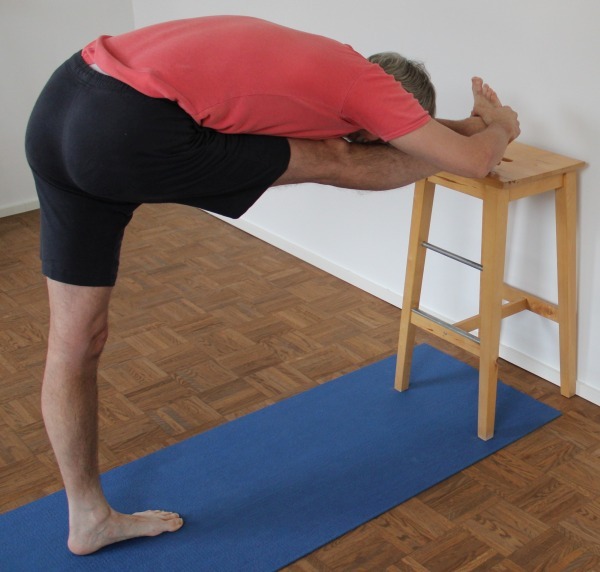
Instruction
- Take hasta padangusthasana as described above but with the heel of the raised leg on an appropriate elevation. When the pose is fully taken, bend the upper body towards the raised leg and place the forehead on the lower leg.
Details
- This variation is somewhat reminiscent of krouncasana and will only be successful if you have good flexibility in the hamstrings. In krouncasana, however, the leg that is folded under usually tilts the pelvis to the side more clearly and unrestrainedly due to the stretching moment in the knee joint caused by the quadriceps. In hasta padangusthasana, this dimension of movement should be relatively unaffected.
- Bending the upper body forwards changes the centre of gravity. Try to draw the foot in rather than simply lowering the upper body forwards and downwards.
parivrtta (twisted)
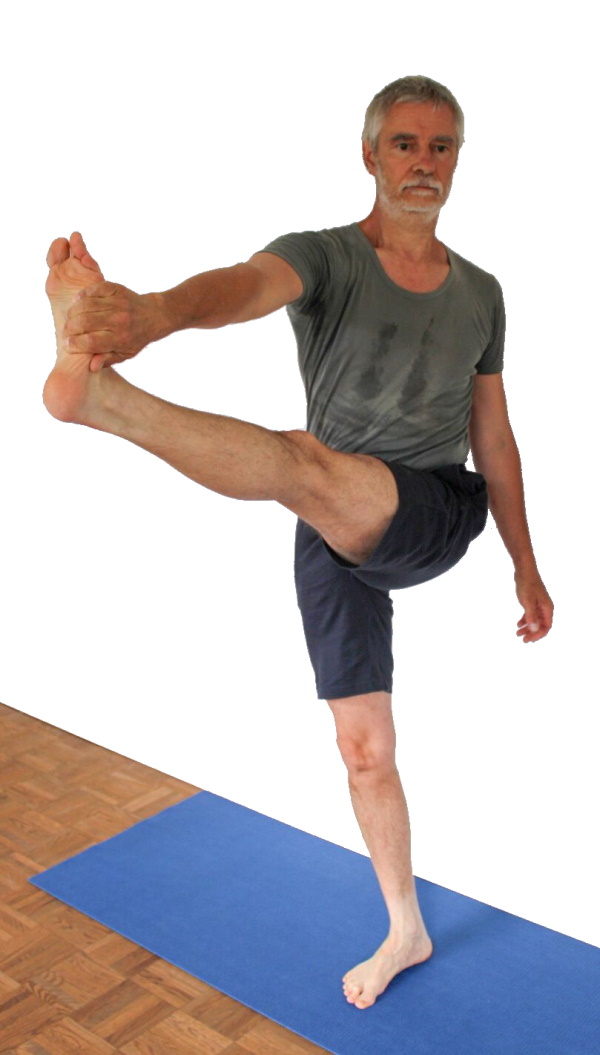
Instruction
- Stand in tadasana.
- Lift the right leg off the floor by bending it at the knee joint and lifting the thigh, leaving the lower leg hanging loose.
- As soon as you can, grasp the right outer foot with your left hand.
- Slowly straighten your right leg. Turn the upper body to the right, the right arm also stretches horizontally to the right.
Details
- Similar to the parivrtta variations of many poses, this variation also requires more flexibility and is slightly more difficult than the normal one.
- Alternatively, you can reach for the big toe (which is easier, preferably grasp with the index and middle fingers) or the heel (which is more intensiv).
- Evasive movements of the pelvis also occur here. The pelvis tends to lift on the side of the lifted leg, turn away from it (abduct the lifted leg in the respective hip joint) and – as far as flexibility allows – tilt backwards. If the hip flexors are not very mobile, the knee joint of the standing leg will bend instead that of the lifted leg. Correct any evasive movements as well as possible. The lifted leg may also tilt forwards and downwards together with the pelvis. Counteract this with the strength of the glutes.
With a belt
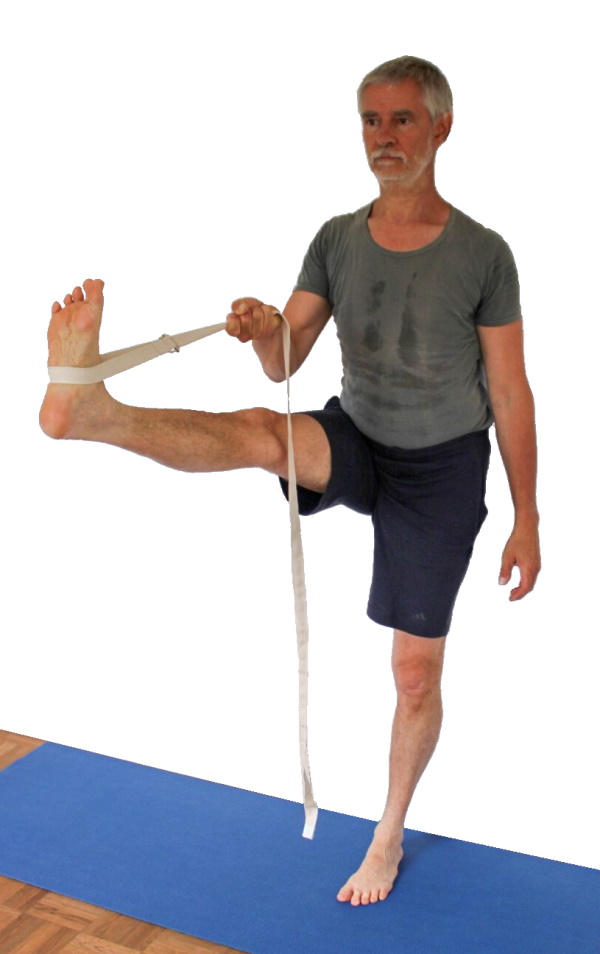
enables to perform the pose with less flexibility
Instructions
- After you have lifted one leg a little, place your foot in the loop of a belt and lift your leg further by pulling on the belt. Stretch it out later.
Details
- This is the for case described above, where the muscles of the hamstrings are not flexible enough to reach the point given by the arm and leg length.
- Do not place the belt too high on the foot, but further towards the heel so that additional intensive stretching of the gastrocnemius does not hinder further lifting of the leg.
With wall

Instructions
- Stand in tadasana facing the wall. There is no useful a priori estimation of the appropriate distance to the wall, determine this by trial and error.
- Release one foot as described in order to lift the corresponding leg.
- Grip the foot, e.g. with your index and middle finger on the big toe, and place the heel on the wall. There is also no a priori indication of the height at which the heel should be placed; it depends very much on the flexibility of the hamstrings, the besser, the higher.
- Extend the lifted leg.
Details
- This variation requires a little getting used to, as neither the optimum height of the heel on the wall nor the optimum distance of the foot from the wall are known beforehand. At the same time, this variation does not appear any more stable than the original: it is not the case that the foot on the wall provides stability, and this is all the more true if only the heel is placed on the wall (see below).
- When the leg is lifted, the hamstrings exert a pull on the pelvis to tilt backwards at the top. Existing flexibility restrictions in the hip flexors quickly cause the knee joint of the standing leg to bend and the pelvis to deviate in several directions.
- From about 20° to the horizontal, no longer should the whole foot be placed on the wall, but only the heel, as on the one hand the friction is then sufficient and on the other hand this causes a better stretching of the hamstrings, as otherwise a limited plantar flexion capability may suggest a bending of the knee joint due to a threatening tendency to cramp in the calf and sole of the foot.
- The optimum height for placing the heel is the height at which the leg can still just be extended. This and the requirement for a stable stance, which requires a certain distance from the wall, determines the position of the stsanding foot.
sideways
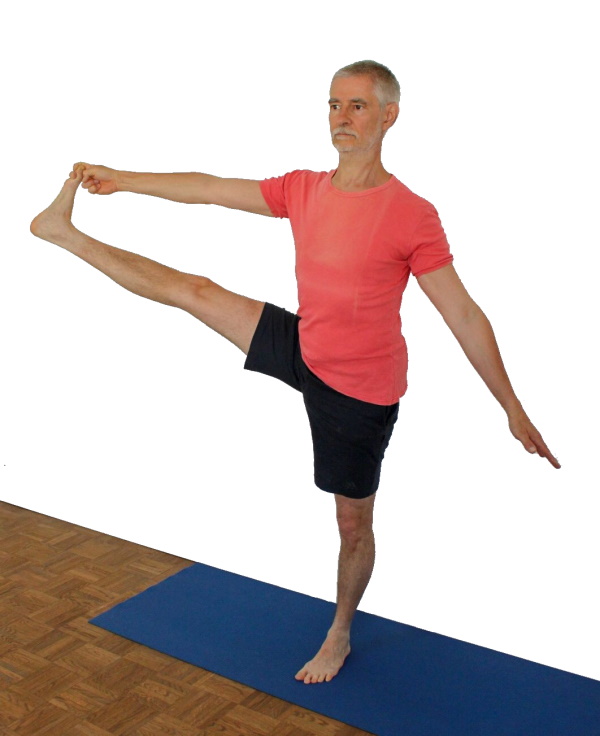
Instructions
- Stand in tadasana.
- Bend one knee joint and lift the leg as far as you can, turn it out a little at the hip joint and grasp the big toe with the index and middle fingers of the hand on the same side.
- Extend the lifted leg.
- Fully turn out the lifted leg in the hip joint, even beyond the vertical of the centre line of the foot.
- Keep the pelvis upright, the standing leg extended and turn the upper body away from the lifted leg.
Details
- This variation has the character of a balancing pose, but also has a clear stretching aspect in the lifted leg, both in the adductors and in the hamstrings.
- Balancing should not be achieved by tilting the pelvis in any direction or bending the knee joint of the standing leg, but by working the muscles of the shank of the standing leg sensitively. As in other similar poses, do not hold the gravity perpendicular close to the outer edge of the foot, but well away from it in the direction of the inner foot, approximately on the midline of the foot, in order to have greater reserves when balancing.
- Keep the pelvis straight and compensate for all evasive movements in all three dimensions of movability of the hip joint.
Sideways with wall
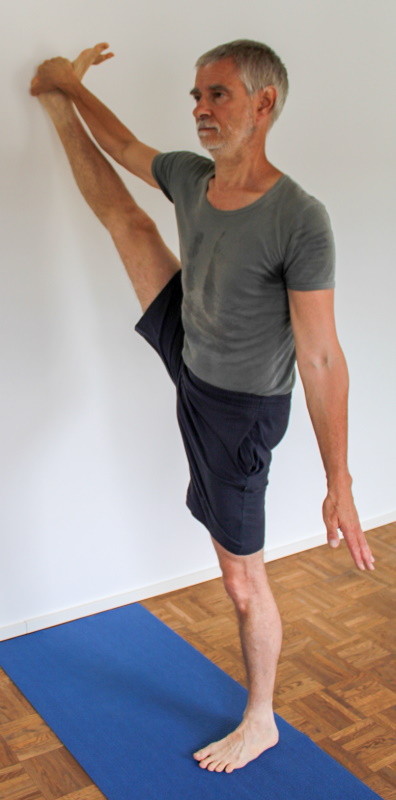
Instruction
- Stand with your pelvis at 90° to the wall, i.e. looking along the wall. It is almost impossible to specify the exact distance. Determine the optimum distance by trial and error.
- Bend the knee joint closer to the wall and raise it high, turn the leg out at the hip joint and place the heel on the wall according to your estimated flexibility.
- Extend the lifted leg. If it is raised 20° more than horizontally, place only the heel on the wall, otherwise the whole sole of the foot.
- Turn the lifted leg out in the hip joint, even beyond the vertical of the centre line of the foot.
- Keep the pelvis upright, the standing leg extended and turn the upper body away from the lifted leg.
Details
- Hasta padangusthasana sideways against the wall corresponds to trikonasana with the raised leg against the wall. Everything said there applies identically here.
- As the leg is lifted, the hamstrings exerts a slight pull on the pelvis to tilt backwards. Due to existing flexibility restrictions in the hip flexors, this will rarely happen; instead, a flexion of the knee joint of the standing leg will quickly occur. As with some other poses, the pull of the hamstrings causes the pelvis to tilt sideways away from the lifted leg, which means that its hip joint must be moved downwards to correct this, in the sense of the other two evasive movements (three-dimensional flexibility in the hip joint means three-dimensional evasion), the pelvis must also erect and turn horizontally away from the lifted leg. The latter is limited by the flexibility of the adductors.
- From about 20° to the horizontal, the whole foot should no longer be placed on the wall, but only the heel, as the friction is then sufficient and the hamstrings is better stretched.
- The lifted leg must turn out as far as possible, even beyond the position in which the knee is pointing straight upwards. This also means that the foot (measured at its centre line) rotates beyond the vertical. The external rotation of the leg is a prerequisite for tilting the pelvis sideways towards the lifted leg, or at least as little sideways away from it as possible. The movement in the hip joint corresponds to an externally rotated abduction in the flexed position. Turning out the leg also encourages the pelvis to erect out of the slight flexion in the hip joint of the standing leg.
- The upper body turns away from the lifted leg without causing the associated hip joint to lift. Turn the head in the same direction as the upper body but, as always, only with that much force that the neck muscles do not start to cramp.
- As soon as possible, grasp the inside of the foot with the hand on the same side in order to turn out the leg in the hip joint from the foot by turning out the arm and supinating the forearm.
Sideways with belt

Instructions
- Stand in tadasana.
- Bend the right knee joint, place the foot in the loop of the belt held by the hand on the side and lift the leg wide. Turn it out from the hip joint.
- Straighten the lifted leg.
- Turn the lifted leg out as far as possible in the hip joint, even beyond the vertical of the centre line of the foot.
- Keep the pelvis upright, the standing leg extended and turn the upper body away from the lifted leg.
Details
- Simply lifting the knee forwards does not cause the centre of gravity to shift sideways, but turning out the leg and, in particular, extending it later does, which is why more balance work must be done and the pelvis must move slightly to the side of the standing leg.
- The points mentioned above about evasive and corrective movements also apply here.
parivrtta (twisted), with belt
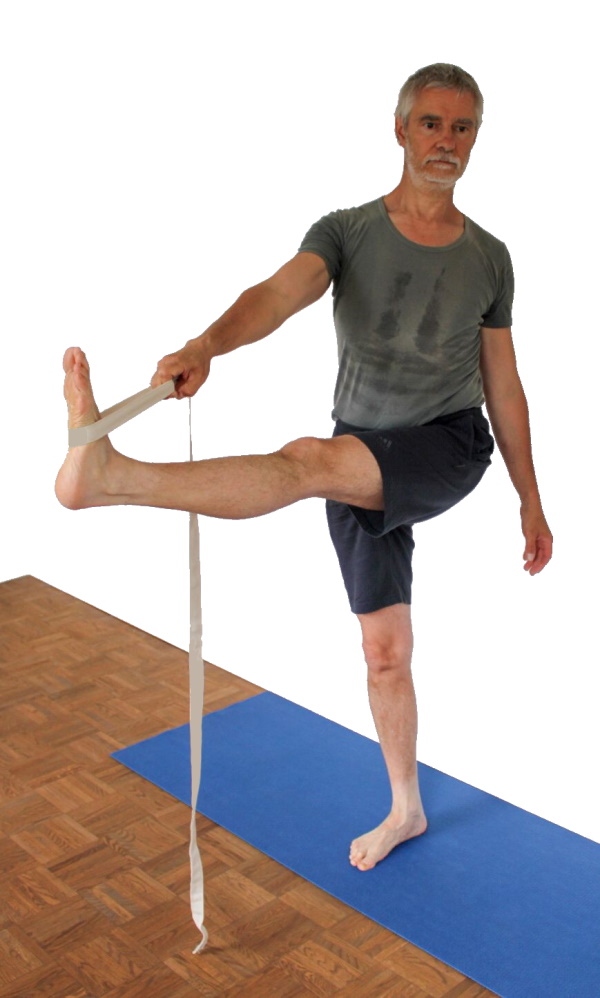
Instruction
- Similar to the variation without a belt, but instead of reaching for the outer foot, place the foot in the loop of a belt immediately after you have lifted your leg a little. Then extend and lift the leg to the maximum.
Details
- Instead of grasping the loop of the belt, you can also grasp its free end, depending on what you find more comfortable. In the one case, the hand and foot are pressed together from the side during an intensive pull, in the other case only the foot, but all the more intensively.
rotated, with wall

Instructions
- Stand in tadasana facing the wall.
- Place the right foot raised on the wall, the exact height depends on your flexibility, but certainly higher than the pelvis.
- Reach the outer edge of the right foot with the left hand.
- Straighten your right leg.
- Turn your upper body to the right, turn your head to the right and stretch your right arm horizontally to the right or along the flank to the floor.
Details
- As in the parivrtta variation, this is a type of standing parivrtta trikonasana, except that the balancing character is less pronounced and the foot must be slightly further away from the wall than the corresponding hip joint, i.e. the leg must be at a slight angle, in order for the heel to exert noticeable counterpressure against the wall.
